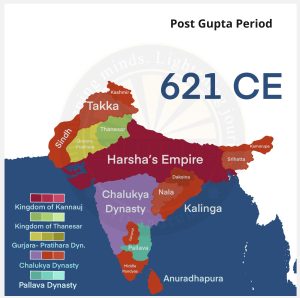Chalukya Dynasty
- They established their kingdom in the Western Deccan at the beginning of the sixth century CE, with Vatapi (modern-day Badami) serving as their capital.
- Pulakeshin I founded this empire. He conducted the Ashvamedha, declaring himself sovereign.
- Pulakeshin II was a well-known ruler, as evidenced by Ravikirti’s eulogistic inscription at Aihole.
- In 610 CE, he invaded Vengi and established a new Chalukyan branch.
- Another notable ruler was Vikramaditya II, who was supposed to have fully defeated the Pallavas.
- They were famed for building stone temples in Karnataka.
- Papanatha Temple and Virupaksha Temple are two major temples.
- Rashtrakutas pulled down the Chalukyas in 757 CE.
Administration
- In contrast to South Indian administrative practice, the Chalukyas of Badami exercised paternalistic control over local administrations.
- King is actively involved in the administration. King was the ultimate judicial authority as well as the head of administration. The majority of Chalukyan kings worked for the benefit of the people.
- There was a council of ministers to advise the king and assist him with governance.
- The Prime Minister was referred to as Mahamatya.
- The kingdom was divided into two districts: ‘Vishya’ and ‘Vishayadhapati’.
- The Chalukyas did not have village autonomy, unlike the Pallavas and Cholas. They were also known for their maritime might, with Pulakeshin II commanding 100 ships and a small army.

Society and Religion
- This period saw the rebirth of Hindu culture and spirituality.
- Vedic ceremonies and rituals were given special importance.
- The rulers generously encouraged Vaishnavism, Shaivism, Shaktism, and Jainism.
- Hsuen Tsang mentioned the fall of Buddhism in Western Deccan. But Jainism remained on the path of progress. Ravikirti, the court poet of Pulakesin II, was a Jain.
- Women were valued throughout society.
Economy
- Income from Land: The state’s income from land appears to be quite minimal, given the majority of the land was rocky and unproductive.
- Trade and Commerce: Earnings from trading activities were also excluded because trade and commerce in India were usually dropping during this period.
- Plundering: Due to the weak status of the economy, the Chalukyas engaged in periodic invasions and looting of adjacent countries. The mutually devastating Chalukya-Pallava conflict can only be understood in this context.
Art and Architecture
- Pattadakal (Raktapura) Group of Monuments
- Ten temples were built in the seventh and eighth centuries, mostly dedicated to Shiva, the most famous of which are the Papanatha temple (CE 680) and the Virupaksha temple.
- A fusion of two important Indian architectural styles, one from north India (Rekha-Nagara-Prasada) and the other from south India (Dravida-Vimana).
- Pattadakal is described by UNESCO as “a harmonious blend of architectural forms from northern and southern India”.
- Badami Temples
- A complex of Hindu and Jain cave temples.
- Virupaksha Temple
- Also known as “Sri Lokeswara Mahashila Prasada”.
- Temple walls represent scenes from the Ramayana.
- Purely Dravidian style of construction.
Prominent Rulers
Pulakesin I (543 CE – 566 CE)
- The first ruler of the Chalukya dynasty.
- Vatapi was established as a city.
- Titles include Vallabheshwar, Satyashraya, Rana-Vikram, Rajasimha, and so on.
- Performed Ashvamedha sacrifices and so adhered to Vedic faith.
- Inscriptions at Badami and Amminabhavi mention Pulakesin I, who was succeeded by his son Kirtivarman I.
Kirtivarman I (566-597 CE)
- The Aihole Inscription indicates that Kirtivarman was “the night of doom” for the Nalas, Mauryas of Konkan, and Kadambas.
- Conquest of the Konkan: Incorporated the vital port of Goa, or Revatidvipa, into the expanding kingdom.
- Inscriptions: The Godachi copper plate inscription mentions Kirtivarman I.
Pulakesin II (608- 642 CE)
- The kingdom rapidly rose to prominence during his reign.
- Titles: Satyashraya, Bhattaraka, Parameshvara and Maharajadhiraja
- Aihole inscription: In CE 630, he vanquished Harshavardhana and earned the title ‘Dakshinapatheshvara’ (lord of the south).
- Hsuen Tsang refers to Pulakeshin’s kingdom as ‘Mo-ho-la-cha’, indicating Pulakeshin’s victory against Harsha.
- Narasimhavarman I, the Pallava king, defeated and killed him at the Battle of Vatapi in CE 642.
Vikramaditya I (644-681 CE)
- He restored order in the fractured kingdom and made the Pallavas retreat from the capital Vatapi.
Decline of Chalukyas
- Following Pulakesin II’s death, the Badami Chalukyas saw a temporary fall due to internal feuds.
- Chalukyas were weak as a result of continued friction with Pallavas and their thirteen-year occupation of Badami.
- The Chalukyas were in continuous wars with Rashtrakutas in later times.
- In about 750 CE, Rashtrakuta feudatory Dantidurga conquered Chalukyan monarch Kirtivarman II, bringing the Rashtrakutas to power in Badami.
